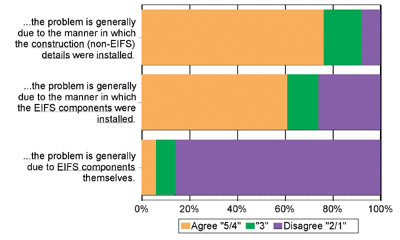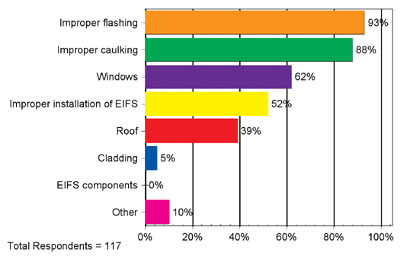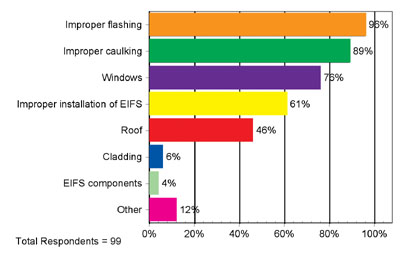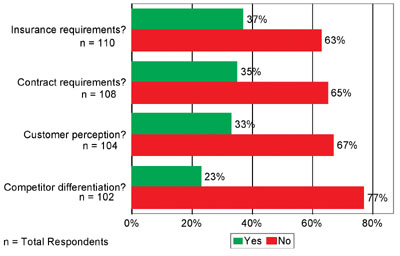

The response rate was 18 percent, meaning 178 contractors responded to the survey, a very strong response rate. Responses came from all over the United States, with 10 percent from California, the highest responding state, 8 percent from Florida, 7 percent from New York, 5 percent from Texas, and 4 percent from Illinois, North Carolina and Minnesota. The rest of the survey came in the 1- to 3-percent range from the remaining states.
Following are some of the highlights of the responses.

The stats
Seventy-two percent surveyed have installed an EIFS system within the past year. Of those who did not, 10 percent replied there was no call for it and 8 percent claimed there was no insurance coverage. Six percent responded it was subbed out. Forty percent replied that they had difficulty obtaining liability coverage for EIFS work in the past year, 33 percent did not have difficulty and 27 percent replied that they did not know, leaving this category fairly even.Another question in the survey asked whether or not difficulty in obtaining coverage affected the contractor’s decision not to install it. Twenty-nine percent said “yes,” while only 17 percent said “no,” while 54 percent felt it was applicable. Ninety nine of the respondents stated that EIFS accounted for 28 percent of their business, with drywall at 27 percent, Portland cement plaster/stucco being 27 percent, drainage EIFS at 11 percent and other claddings accounting for 7 percent of the business. Roughly half do commercial with only 13 percent doing strictly residential and 43 percent doing both.
Compared to 2001, 42 percent agreed that their EIFS installations remained about the same in 2002, with 18 percent citing an increase and 40 percent citing a decrease, a large number reflecting the challenging times the industry currently faces. Fifty-seven percent expect 2003 to be about the same with 25 percent expecting a decrease and only 18 percent expecting an increase.
The survey seems to indicate all EIFS contractors could use a brush-up regarding EIFS and building codes. On a scale of “1” to “5” with 5 being “very familiar with building codes and EIFS,” and 1 being “not familiar at all,” 44 percent considered themselves “5,” while 31 percent were “4,” 13 percent were “3,” 10 percent were “2,” and 2 percent were “1.”
Another question in the survey was “in the past year, have you used stucco on a project that was originally planned to be constructed using EIFS?” Thirty-six percent replied “yes,” and 64 percent said “no.” Of those who replied yes, 10 percent cited an owner’s choice or architectural change, 5 percent cited insurance problems, 4 percent said cost and 3 percent stated fear of moisture-related problems. Other reasons included building contractor afraid of EIFS, stigma, new reports, the owner found out negative information on the Internet and the building inspector rejected it.

of operation due to...
Where is the industry at?
Only 21 percent of the respondents indicated that their company has implemented an increased amount of third-party EIFS training in the past two to three years. Seventy percent are more concerned now than a year ago about the need for quality construction of the entire building/wall envelope. Twenty seven percent felt the same as in 2001.The respondents seemed to have mixed feelings about the future of the EIFS industry. Thirty-five percent felt that on a scale of 1 to 5, with 5 being “very optimistic,” that 3 best described the future. Twenty-seven percent gave a “4,” which is looking positive, while 18 percent gave a “5,” being very optimistic. Only 13 percent gave a “2” and 7 percent gave a “1.”
The respondents were asked to give some feedback about the EIFS industry today vs. three years ago. The following are some of the verbatim responses:
• Getting better.
• Remains the same.
• Advances in technology overshadowed by bad press of past failures.
• Architects/GCs/subs/homebuilders are afraid of lawsuits—GCs and homeowners cannot get insurance.
• As long as it’s properly installed and caulked, it remains a good product.
• Awareness of contractor competency is much higher, uncertified contractors are being weeded out.
• Better, more positive advertisement needs to be conducted by the industry.
• Conditions and demand seem about the same, the main problem is insurance coverage.
• EIFS companies, manufacturers and distributors have not done their job educating the public and the insurance companies about EIFS.
• Public perception is behind the latest improvements in EIFS.
• EIFS contractors are fewer and better educated.
• EIFS is a great system and is getting better with new materials/EIFS installed in the proper manner is a great product.
• EIFS manufacturers and dealers must strictly enforce specification and standards of training.
• EIFS sales need to be limited to trained/certified plasterers; it’s the untrained people who are having all the problems when it is not installed correctly.
• Brick, stucco, siding, etc., can all have water intrusion if other elements of the project are not installed correctly.
• Need more direct involvement by the manufacturers in certifying “qualified” installers and taking care not to sell the product to uncertified installers who are giving the product a bad name.
• Owners must be taught how to inspect and repair sealants on dissimilar surfaces. Installers must install correct kick-out flashing and properly seal the job.
• Problems have been addressed and solutions provided, the industry did not back away and the approach will eventually pay a dividend.
• We have seen a slight decline of jobs specifying EIFS but I believe EIFS will be a very good system and will recover 100 percent.
The survey seems to indicate that things have changed somewhat in the last year and that the main concerns are proper installation and insurance coverage. Proper installation guarantees product success, product success makes EIFS an insurable product. Many respondents call for more direct training and qualification in order to install EIFS.
Despite so much negativity in the press and some of the very frightened contractors out there with problems getting insurance coverage, the consensus remains that EIFS is a fine product and that more vigilance is required to ensure its proper installation. Under the circumstances of qualified installers installing the product correctly, insurance companies will eventually recognize the root of the scare and any stigma from bad press will be the exception and hardly the rule.
